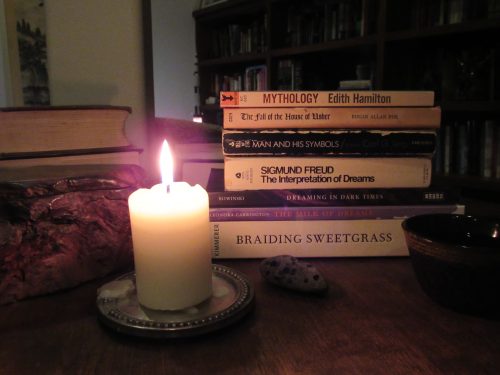 An outbreak of war and violent conflict is very likely to prompt a wave of nightmares of traumatic experiences, mournful losses, and threat simulations. This seems to be part of our internal crisis-response system when the external world descends into chaos and bloodshed, and our minds struggle to make sense of what is happening and find a way to survive the dangers.
An outbreak of war and violent conflict is very likely to prompt a wave of nightmares of traumatic experiences, mournful losses, and threat simulations. This seems to be part of our internal crisis-response system when the external world descends into chaos and bloodshed, and our minds struggle to make sense of what is happening and find a way to survive the dangers.
A few days after the Russian invasion of Ukraine, I had a conversation with two journalists from Eastern Europe who were working on a project relating to dreams. The focus of their project was not the war, but it inevitably came up in our conversation. They shared a couple of dreams with me, and afterwards sent me another from a friend of theirs. With their permission, I am sharing the dreams below. I find the dreams haunting, horrifying, profoundly creative, and ultimately hopeful.
P., 27 years, male, a semiotics graduate from Czechia
A few days after the start of the war in Ukraine I had this dream:
I went to visit my parents at their house in a Czech village. I wanted to talk to them that night about everything that happened after the war started, but the conversation didn’t go as well as I had hoped and it wasn’t a very warm meeting. I felt disappointed.
Then I was all alone in the room when suddenly I heard a crackling sound from outside. I turned to the window and I saw a great rising glow that blinded me completely. I knew it was a nuclear bomb explosion, and at that moment time seemed to stop for a while. I realized that these were the last moments of my life. (I even recalled some fragments of my life passing through my mind.) Then I woke up.
At first, I wanted to forget about the dream, it felt too horrifying, but then I realized that maybe it is useful in something. It allowed me to imagine an absolute ending, the worst-case scenario. The next morning, I felt different, as if I had to do everything in my life from now on to ensure, such a situation would never happen.
P., 27 years, male, a semiotics graduate from Czechia
I was walking down a street of a historic town, alone or with a friend. I saw two political marches going against each other, one with banners over their heads with microscopes drawn on them, and the other with wooden swords. There was a tension rising, and I wouldn’t expect they would attack each other, which they did, and suddenly it was chaos everywhere on the street. I thought, ok well maybe there was a chance I would expect they could start fighting, but still I wouldn’t expect it would get so harsh, given the fact that their wooden swords were clearly only replicas of the real medieval weapons. So I went on to hide in a back street, but it was noise all over the place, it was a nightmare. I woke up.
R., 27 years, female, Slovak student of filmmaking and French philology
Personally, I can only recall one fragment of a dream linked with tanks. The dream contained some banal everyday story, which I don’t remember and meanwhile, tanks were coming in the night by streets accompanied by something between fireworks and airstrikes, the night sky over the tanks was spectacularly on fire. In the dream, the tanks that kept coming felt like everyday routine.
The interesting thing is, I’ve heard from three more friends from Prague, that they also dreamed about tanks in particular. My first guess “why” is about something deeply rooted in the historical memory of local people. When someone says “when tanks arrived”, or just “the tanks” most of the time it refers to the Occupation of Czechoslovakia in the August of 1968. In general, mostly the older generations use this term(s). Also, many people at protests or in the media are making this reference nowadays- between the tanks of the Warsaw Pact troops back in 1968 in Czechoslovakia, and Russian tanks in the war with Ukraine now.
M., 27 years, female, Slovak translator and student
(I experience the worst intrusive images of violence associated with war during the day, probably also tied to the fact that I work as a translator for Memory of Nations, thereby I work with recollections of torture (by Nazis), hiding before Russian soldiers liberating Czechoslovakia, who were looting and looking for women to rape, interrogations by State Secret Services etc daily.)
“Amongst the few dreams about the war in Ukraine, I can most vividly recall the following. At that time, I had a fever, it was approximately 4 days after the war started and we were preparing some items to donate to a local charity.
Dream: I work in the local charity, we are collecting the items and sorting them for transport to the Ukrainian border. Lorries with new items keep coming, the hall is full of boxes with clothes, sleeping bags, toys, food, we are working day and night to sort the incoming material help, but it is impossible. We start to receive many calls, amongst them also video calls from Ukrainian president Mr Zelenskyj. In the style of his famous video-addresses to the world and his own citizens, each of the calls are like a short vlog, in which he encourages Ukrainians to fight, calls others to help and reprimands us for not working efficiently. With every call, the addresses become more bizarre, Zelenskyj becomes angrier and at the end, the calls purely consist of Zelenskyj absurdly scolding us for being lazy, disorganized, responsible for many deaths because we cannot even sort out material help properly.”

 This has been a rough season for fans of the Portland Trailblazers basketball team. The players are learning a new system from their rookie head coach, Chauncey Billups, in his first season in that role. Their star player, Damien Lillard, plays poorly (by his standards) at the outset, then is forced to undergo season-ending surgery. Three other players in the original rotation—Cody Zeller, Larry Nance Jr., and Nassir Little—go down with injuries. The General Manager of the team, Neil Olshey, is summarily fired after years of internal conflict, leaving the operations in the hands of neophyte executives and detached ownership. Just before the trade deadline they deal away three of their best remaining players—Norman Powell, Robert Covington, Jr., and the beloved C.J. McCollum. In return the Blazers receive some promising guys (Josh Hart, Justice Winslow, Keon Johnson), plus draft picks and salary cap flexibility (an aspect of the game I don’t understand and don’t want to understand). In the midst of it all, the team wins a few surprising games, but loses many more, often by huge margins. Now, with a season-ending injury to Jusuf Nurkic, the lone remainder from the starting line-up at the beginning of the season, the Blazers have been reduced to a fragment of what they hoped to become this year.
This has been a rough season for fans of the Portland Trailblazers basketball team. The players are learning a new system from their rookie head coach, Chauncey Billups, in his first season in that role. Their star player, Damien Lillard, plays poorly (by his standards) at the outset, then is forced to undergo season-ending surgery. Three other players in the original rotation—Cody Zeller, Larry Nance Jr., and Nassir Little—go down with injuries. The General Manager of the team, Neil Olshey, is summarily fired after years of internal conflict, leaving the operations in the hands of neophyte executives and detached ownership. Just before the trade deadline they deal away three of their best remaining players—Norman Powell, Robert Covington, Jr., and the beloved C.J. McCollum. In return the Blazers receive some promising guys (Josh Hart, Justice Winslow, Keon Johnson), plus draft picks and salary cap flexibility (an aspect of the game I don’t understand and don’t want to understand). In the midst of it all, the team wins a few surprising games, but loses many more, often by huge margins. Now, with a season-ending injury to Jusuf Nurkic, the lone remainder from the starting line-up at the beginning of the season, the Blazers have been reduced to a fragment of what they hoped to become this year. A Dream Library is a playground for studying and dreaming: for studying while dreaming, and dreaming while studying. It’s a spatial technology for stimulating your oneiric imagination. It’s not a shrine to dreaming, but it’s not not a shrine to dreaming, either. It’s your personally crafted portal into the intuitive depths of your own mind.
A Dream Library is a playground for studying and dreaming: for studying while dreaming, and dreaming while studying. It’s a spatial technology for stimulating your oneiric imagination. It’s not a shrine to dreaming, but it’s not not a shrine to dreaming, either. It’s your personally crafted portal into the intuitive depths of your own mind. Of SUVs, prosperous males, and watching witches.
Of SUVs, prosperous males, and watching witches. As a dream researcher, I try to promote public interest in dreaming and its many exciting possibilities. And yet also as a dream researcher, I try to highlight potential problems and misleading claims that can do more public harm than good. This creates a dilemma with the topic of lucid dreaming, which is increasingly popular and yet has pitfalls and drawbacks that its advocates rarely mention or even seem to know exist.
As a dream researcher, I try to promote public interest in dreaming and its many exciting possibilities. And yet also as a dream researcher, I try to highlight potential problems and misleading claims that can do more public harm than good. This creates a dilemma with the topic of lucid dreaming, which is increasingly popular and yet has pitfalls and drawbacks that its advocates rarely mention or even seem to know exist. The Blazers beat the Memphis Grizzlies, 116-96, last Wednesday night, to even their season’s record at 2 wins and 2 losses. They played excellent defense and held Ja Morant, the Grizzlies’ young star guard, to 17 points, half of what he had been averaging the first few games of the season. The Blazers had a strong second half, with more amazing dance-and-shoot moves from C.J. McCollum, who plays with astonishing grace and fluidity. He excels at step-back jumpers, mid-lane floaters, sneaky inside drives, and quick-release 3-pointers, always hunting for the spots where he knows he can elevate and hit his shot. Damien Lillard played well enough on offense to give C.J. room to maneuver, which seems to be part of the season’s overall design. And the bench continues to gain in confidence and cohesion. There was a great play towards the end of the game when Dennis Smith, Jr. took a C.J. Elleby outlet and made a touch pass to Greg Brown for an alley-oop dunk. Everybody loves to see that.
The Blazers beat the Memphis Grizzlies, 116-96, last Wednesday night, to even their season’s record at 2 wins and 2 losses. They played excellent defense and held Ja Morant, the Grizzlies’ young star guard, to 17 points, half of what he had been averaging the first few games of the season. The Blazers had a strong second half, with more amazing dance-and-shoot moves from C.J. McCollum, who plays with astonishing grace and fluidity. He excels at step-back jumpers, mid-lane floaters, sneaky inside drives, and quick-release 3-pointers, always hunting for the spots where he knows he can elevate and hit his shot. Damien Lillard played well enough on offense to give C.J. room to maneuver, which seems to be part of the season’s overall design. And the bench continues to gain in confidence and cohesion. There was a great play towards the end of the game when Dennis Smith, Jr. took a C.J. Elleby outlet and made a touch pass to Greg Brown for an alley-oop dunk. Everybody loves to see that.